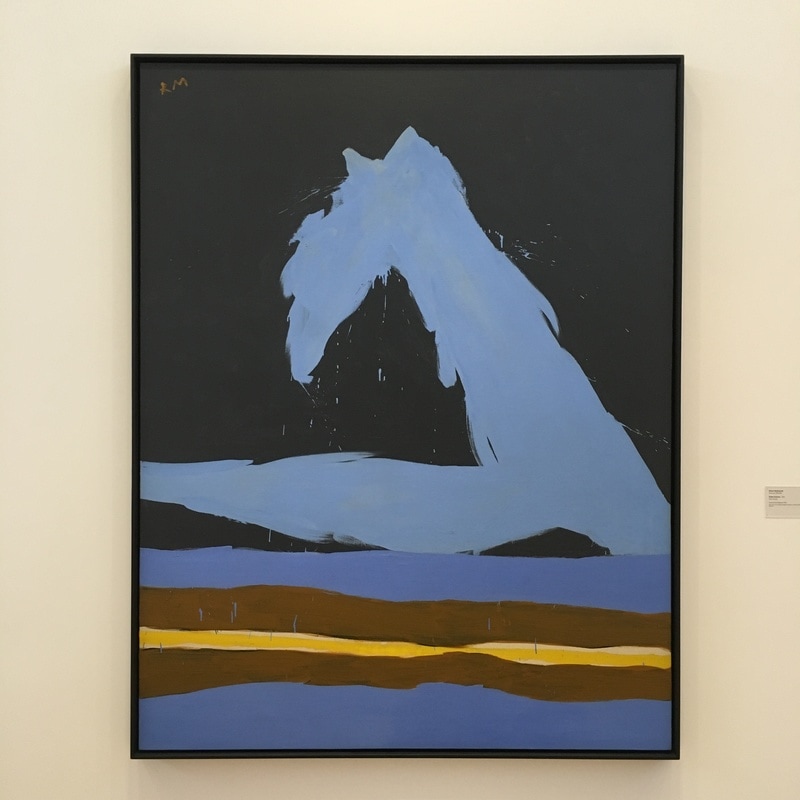It was the summer of 1962; Robert Motherwell and his then-wife Helen Frankenthaler were living in the artists’ colony at Provincetown, Massachusetts. “Surfer Magazine” was picking up steam and The Beach Boys were working on their iconic album “Surfin’ USA” set to release the next year. The vibrant youth culture of the 1960s was in full swing on the beaches which surrounded Provincetown, and Motherwell was unavoidably immersed. During this summer, Motherwell produced a series of paintings called “Beside the Sea,” consisting largely of bright canvases overlaid with energetic splashes of paint, which abstract the form of waves crashing on shore.
The set constitutes some of Motherwell’s most famous work. A painting from this series, “Italian Summer,” is here in the Anderson Collection at Stanford University. A brilliant splash of azure paint thrown over the top of a black background. A sharp ark which rises from the deeper bar of blue on which it rests. The swath of yellow calls to mind the golden sand of a beach, surrounded on both sides by the blue paint, like the water which surrounds Provincetown. The piece is both abstract and unquestionably fluid; one can see both the wave the artist imitates and the motion which he uses to cast paint onto the canvas. The piece vibrates with an energy barely contained. The bright blue stands in sharp contrast to the dark background, unlike most of the pieces in the “Beside the Sea” series where the background is brighter than the wave of paint which is imposed upon it. This is not a painting of the bright sunny days of the summer of 1962.
The laid-back sounds of the Beach Boys’ 1963 album tell you all you need to know about the romanticized beach-going lifestyle which drew hordes of young people to the Massachusetts coastline during Motherwell’s stay at the colony. The highway culture of the 1950s had impressed the freedom of movement onto the American consciousness, and what could be freer than the freewheeling, uncommitted surfer lifestyle. Of course, Motherwell wasn’t a young man anymore. He was already in his late 40s and had a wife as well as a successful career as an artist. The freedom which was taking place just outside his door was not his to grasp. It does not seem too far a stretch to say that, as Motherwell watched life take place all around him, he might have looked back into his own past, to the days of his youth, when he might have thrown himself into this culture without the reservations of commitment and age.
At 20, Motherwell traveled to the Amalfi Coast during a tour of Europe, while taking time off from his studies at Stanford. The title of the piece, “Italian Summer,” unquestionably draws this earlier experience into play. The excitement of summer in Provincetown must have recalled Motherwell’s nostalgic youth on the Amalfi Coast, basking in the Italian sun and swimming in the Mediterranean water. We must imagine that these were wonderful memories, nonetheless viewed through the melancholy lens of middle age. It is here that we might source the conflict of the painting. The tension between the artist’s youthful memories and his mature commitments manifests itself in the dynamism of the wave which seems to wash over the overarching shadow of its background. Motherwell’s humanness can’t help but take hold in this painting as it navigates the boundary between reminiscent pleasure and nostalgic longing for a youth long since passed.
As with most abstract work, it is difficult to know exactly what thoughts drove Motherwell’s hand as he cast his paint onto this canvas. However, given the name of the piece, the location of its production and the artist’s own history, we can gain some insight into the mind of the artist. The conflict between energy and shadow which is present here makes it both conceptually interesting and wonderful to look at. The uniqueness of its execution, even among the peers in its set, makes it an especially pertinent point of analysis within the breadth of Robert Motherwell’s work.
Contact Reily Haag at mrhaag ‘at’ stanford.edu.
